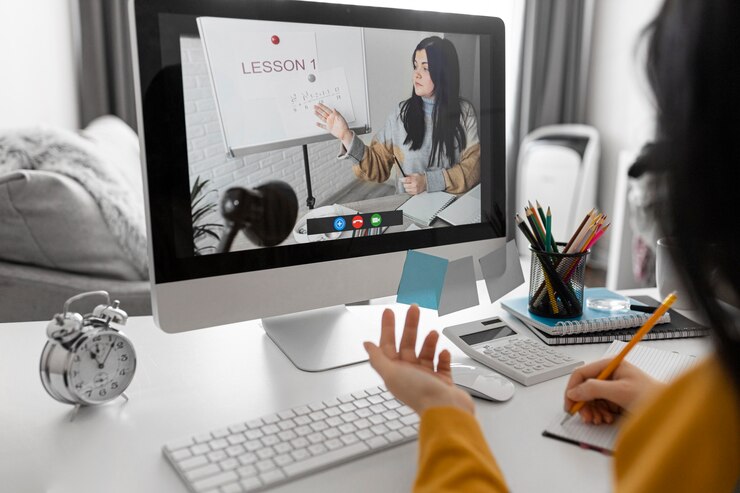Introduction
In the realm of online education, one size does not fit all. As virtual classrooms continue to redefine how we learn, understanding and adapting to different learning styles has become crucial for maximizing educational outcomes. Whether you’re a visual learner who thrives on graphics and diagrams, an auditory learner who absorbs information through listening, a kinesthetic learner who benefits from hands-on activities, or a combination of these, online education offers a wealth of opportunities to cater to diverse learning preferences.

The landscape of online learning is characterized by its flexibility and accessibility, allowing students to engage with course material in ways that best suit their individual learning styles. This flexibility extends beyond the traditional confines of a physical classroom, empowering learners to customize their learning experiences and take ownership of their educational journeys. By embracing diverse learning styles, online education not only accommodates varying needs but also enhances engagement, retention, and overall academic success.
This article delves into the intricacies of different learning styles in the context of online education, exploring strategies and tools that cater to each style. From interactive simulations and virtual labs for kinesthetic learners to multimedia presentations and podcasts for auditory learners, the digital realm offers a multitude of resources to support diverse learning preferences. By identifying your unique learning style and leveraging the resources available in online education platforms, you can optimize your learning experience, achieve deeper comprehension, and foster lifelong learning habits.
Join us as we navigate the dynamic landscape of online education, uncovering how different learning styles intersect with digital learning environments to create personalized and effective educational experiences. Whether you’re embarking on a new academic pursuit or seeking to enhance your professional skills, understanding and harnessing your preferred learning style can significantly enrich your online learning journey.
Understanding Different Learning Styles
In the realm of online education, understanding and accommodating different learning styles are essential for optimizing learning experiences and ensuring educational success. Learning styles refer to the various ways individuals prefer to approach learning and absorb information. While some learners may excel with visual aids such as diagrams, charts, and videos, others may prefer auditory methods such as lectures, podcasts, and discussions. Additionally, kinesthetic learners thrive through hands-on activities, interactive simulations, and virtual labs where they can actively engage with the material.
Visual learners typically grasp information best when it is presented in a visual format. Online education platforms cater to this style by offering multimedia content, infographics, and interactive diagrams that aid in comprehension and retention. For instance, courses may include video lectures, animated tutorials, and visual summaries to supplement textual information, providing a comprehensive learning experience.
Auditory learners, on the other hand, prefer learning through listening and verbal communication. Online education accommodates auditory learners by offering recorded lectures, podcasts, and audio-based discussions. These resources allow learners to absorb information through sound and engage in dialogue with instructors and peers, fostering deeper understanding and critical thinking skills.
Kinesthetic learners learn best through physical interaction and hands-on experiences. Online education platforms address this learning style by incorporating interactive elements such as virtual labs, simulations, and interactive exercises. These tools enable kinesthetic learners to actively manipulate and experiment with concepts, reinforcing learning through practical application and experiential learning.
Understanding and recognizing these different learning styles in online education is crucial for educators and learners alike. By identifying their preferred learning style, students can select courses and utilize resources that align with their strengths, thereby enhancing their learning outcomes and academic performance. Educators can also adapt teaching strategies and instructional materials to accommodate diverse learning preferences, promoting inclusivity and engagement in virtual classrooms.

Tools and Techniques for Visual Learners
Visual learners, who absorb and process information most effectively through visual aids, benefit significantly from the diverse array of tools and techniques available in online education. These learners thrive on seeing information presented in graphical or pictorial formats, which enhance their comprehension and retention of knowledge.
One of the primary tools for visual learners in online education is multimedia content. Video lectures, animated tutorials, and visual presentations play a crucial role in delivering course material. These resources allow visual learners to engage with complex concepts through dynamic visuals and demonstrations, making abstract ideas more tangible and easier to understand. For example, in a biology course, visual learners may benefit from animated diagrams illustrating biological processes like cell division or photosynthesis.
Infographics and charts are also invaluable tools for visual learners. These visual representations condense complex information into digestible formats, facilitating quick understanding and comparison of data. Online courses often include infographics to summarize key concepts, timelines, or statistical data, providing visual learners with a comprehensive overview that complements textual information.
Interactive diagrams and concept maps are another effective tool for visual learners. These tools allow learners to explore relationships between ideas, concepts, and information visually. Online platforms often integrate interactive features that enable learners to manipulate elements within diagrams, enhancing engagement and facilitating deeper understanding of interconnected topics. For instance, in a history course, interactive timelines can help visual learners visualize historical events and their chronological sequence.
Virtual reality (VR) and augmented reality (AR) are emerging technologies that hold promise for visual learners in online education. These immersive technologies allow learners to experience simulations and virtual environments, bringing learning material to life in a way that traditional textbooks cannot. For example, VR simulations can transport learners to historical landmarks or scientific laboratories, providing hands-on experiences that enhance learning and retention.

Strategies for Auditory Learners in Online Education
Auditory learners, who absorb and retain information best through listening and verbal communication, can maximize their online learning experience through various strategies tailored to their learning style. Online education platforms offer a range of resources and techniques that cater specifically to auditory learners, facilitating deeper comprehension and engagement with course material.
One of the most effective strategies for auditory learners in online education is access to recorded lectures and audio-based content. Many courses provide recorded lectures that students can listen to at their convenience. These lectures often include explanations, discussions, and demonstrations that auditory learners find beneficial for absorbing information through sound. For instance, in a literature course, students may listen to readings of literary works accompanied by critical analyses, enhancing their understanding and interpretation skills.
Podcasts and audio resources are also valuable tools for auditory learners. Online education platforms often feature podcasts on various subjects, hosted by educators or experts in the field. These podcasts cover relevant topics, provide insights, and engage listeners through interviews, debates, and discussions. Auditory learners can listen to podcasts during commutes, workouts, or downtime, effectively incorporating learning into their daily routines and reinforcing their understanding of course material.
Discussion forums and virtual classrooms play a pivotal role in supporting auditory learners’ engagement and learning experience. These platforms enable students to participate in audio-based discussions, debates, and collaborative activities with peers and instructors. Auditory learners benefit from verbal interactions and dialogue, which stimulate critical thinking, perspective-sharing, and deeper understanding of diverse viewpoints. Active participation in discussions allows auditory learners to articulate their thoughts verbally, reinforce their knowledge, and develop communication skills crucial for academic and professional success.
Auditory learners also benefit from mnemonic techniques and verbal repetition. Online platforms may offer interactive quizzes, flashcards with audio cues, and mnemonic devices that utilize rhymes or acronyms to aid memory retention. These tools help auditory learners reinforce learning through auditory repetition and association, improving recall and comprehension of key concepts.
Engaging Kinesthetic Learners with Hands-On Activities
Kinesthetic learners thrive on physical interaction and hands-on experiences to understand and retain information effectively. In the context of online education, engaging these learners requires creative integration of interactive and experiential activities that simulate real-world scenarios and allow for active participation.

One effective strategy for engaging kinesthetic learners in online education is through virtual labs and simulations. These interactive tools replicate laboratory experiments, practical exercises, and fieldwork experiences in a digital format. For example, in a physics course, kinesthetic learners can manipulate virtual objects, conduct experiments, and observe outcomes in real-time simulations, facilitating a deeper understanding of theoretical concepts through practical application.
Another approach is through interactive exercises and games that require physical engagement. Online platforms offer gamified learning modules where kinesthetic learners can solve puzzles, complete tasks, and navigate challenges that require physical interaction with the content. These interactive elements not only enhance engagement but also promote active learning and problem-solving skills development.
Hands-on projects and assignments are essential components of online courses for kinesthetic learners. These projects allow students to apply theoretical knowledge to practical tasks, such as creating models, conducting surveys, or designing experiments. For instance, in a biology course, kinesthetic learners may design and build a model of a cell structure or conduct a virtual dissection, gaining practical experience and reinforcing their understanding of biological concepts.
Physical manipulatives and tactile resources also play a crucial role in engaging kinesthetic learners online. Some courses provide digital tools that simulate tactile experiences, such as touch-sensitive interfaces or 3D modeling software. These resources allow kinesthetic learners to manipulate objects, explore spatial relationships, and engage in kinesthetic learning activities that promote sensory engagement and experiential learning.
Collaborative group activities and peer-to-peer interactions further enhance the learning experience for kinesthetic learners. Online platforms facilitate group projects, role-playing exercises, and collaborative problem-solving tasks that require teamwork and shared responsibility. These activities promote social interaction, communication skills, and cooperative learning, which are beneficial for kinesthetic learners’ holistic development.
Combining Learning Styles: Strategies for Mixed Learners
In online education, many learners exhibit mixed learning styles, incorporating elements of visual, auditory, and kinesthetic preferences. Strategies that cater to mixed learners aim to provide diverse learning experiences that accommodate various learning modalities, ensuring comprehensive understanding and engagement with course material.
One effective strategy for mixed learners is multimedia integration. Online courses often incorporate a combination of visual, auditory, and interactive elements to appeal to diverse learning preferences. For example, a history lecture may include video presentations supplemented with audio commentary and interactive timelines, allowing learners to engage with content through multiple sensory channels.
Adaptive learning technologies play a crucial role in catering to mixed learners’ needs by personalizing learning experiences based on individual learning styles. These technologies utilize algorithms to assess learner performance and preferences, adapting course content, pace, and assessments accordingly. For instance, an adaptive learning platform may recommend additional visual aids for visual learners, audio-based explanations for auditory learners, and interactive simulations for kinesthetic learners based on their learning patterns and feedback.
Flexible learning pathways are essential for accommodating mixed learners in online education. Online platforms often offer diverse resources and alternative learning formats that allow learners to choose how they engage with course material. For example, learners may opt to watch video lectures, listen to audio recordings, or participate in interactive activities based on their preferences and learning needs.
Incorporating project-based learning and case studies is another effective strategy for mixed learners. These approaches provide real-world applications and scenarios that appeal to diverse learning styles. For instance, in a business course, mixed learners may collaborate on a case study project that involves analyzing data visually, discussing findings audibly, and presenting solutions kinesthetically, fostering holistic understanding and skill development.
Collaborative learning environments also benefit mixed learners by promoting peer interaction and knowledge exchange. Online platforms facilitate group discussions, collaborative projects, and virtual teamwork activities that encourage diverse perspectives and collaborative problem-solving. These interactions allow mixed learners to leverage their strengths while gaining insights from peers with different learning styles, enhancing overall learning outcomes.

Conclusion
Understanding and accommodating different learning styles in online education is key to creating personalized and effective learning experiences. Whether you are a visual learner who benefits from multimedia content, an auditory learner who thrives on recorded lectures and discussions, or a kinesthetic learner who learns best through hands-on activities and simulations, online education offers a wealth of resources and strategies to support your preferences.
By identifying your preferred learning style and leveraging appropriate tools and techniques, you can optimize your learning experience, enhance comprehension, and retain knowledge more effectively. The flexibility and accessibility of online platforms allow learners to tailor their educational journey according to their unique strengths and needs, fostering engagement and motivation throughout the learning process.
As technology continues to advance, so too will the opportunities for integrating diverse learning styles into online education, ensuring that learners worldwide have access to personalized and inclusive learning experiences that promote academic success and lifelong learning.
Stay Tune MeaningMe The Meaning of Life
FAQ: Exploring Different Learning Styles in Online Education
What are the main learning styles, and how do they impact online education?
The main learning styles include visual, auditory, reading/writing, and kinesthetic. Understanding your learning style can help you choose the right online education methods and tools that enhance your learning experience and retention.
How can visual learners optimize their online education experience?
Visual learners can optimize their experience by using video lectures, infographics, diagrams, and mind maps. Platforms offering visual aids such as animations and visual explanations can be particularly beneficial.
How can reading/writing learners succeed in online courses?
Reading/writing learners thrive on written materials such as textbooks, articles, and lecture notes. They can take detailed notes, create lists, and write summaries to reinforce learning. Engaging in written discussions and forums is also effective.
What techniques are effective for kinesthetic learners in online education?
Kinesthetic learners benefit from hands-on activities, interactive simulations, and practical exercises. They should look for courses with labs, projects, and real-world applications, and incorporate movement or breaks into their study routines.
How can online educators accommodate different learning styles?
Online educators can accommodate different learning styles by offering diverse types of content, such as videos, podcasts, written materials, interactive activities, and practical exercises. They can also provide opportunities for group work and discussions.
What are the benefits of understanding and utilizing your learning style in online education?
Understanding and utilizing your learning style can lead to more effective studying, increased retention of information, higher engagement and motivation, and overall better academic performance. It helps tailor the learning process to individual needs, making education more personalized and effective.




